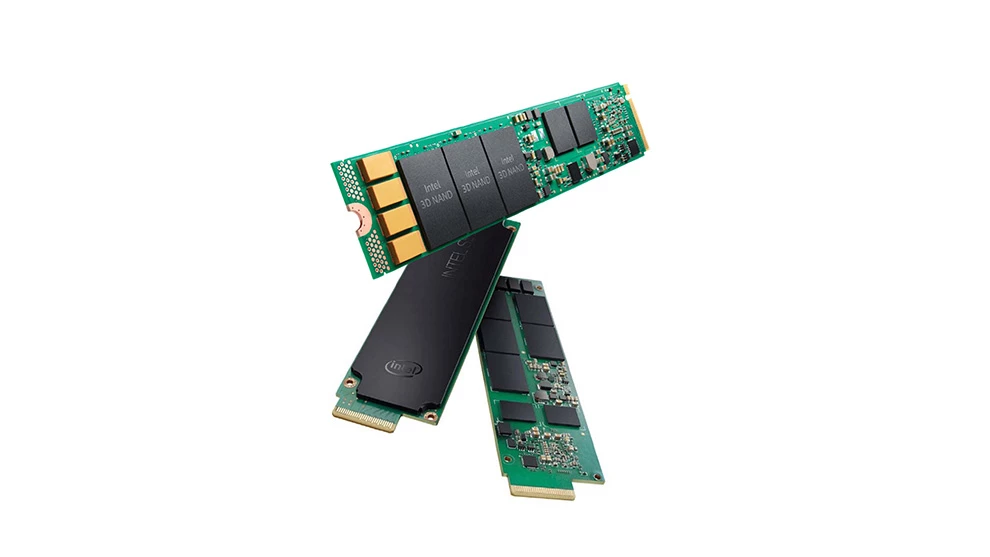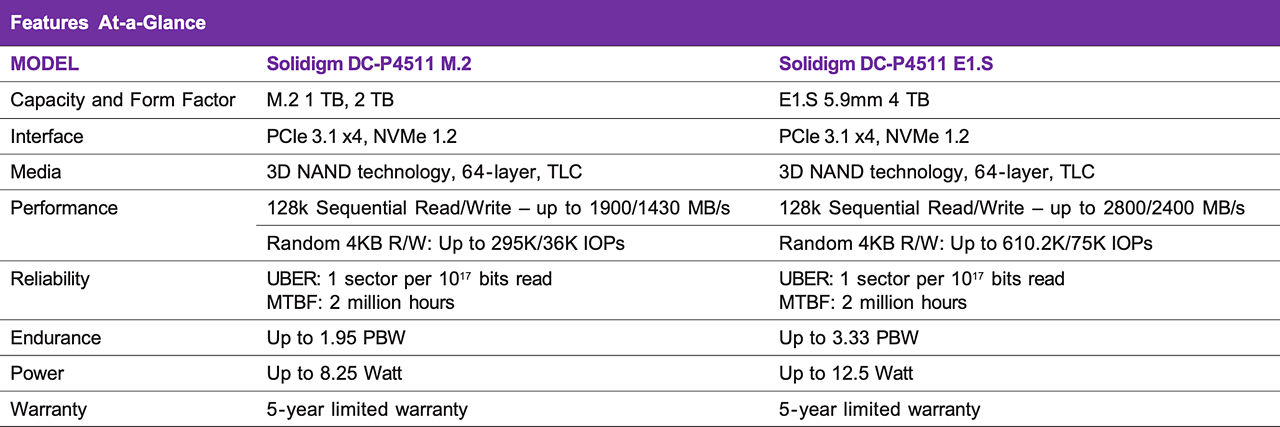Solidigm™ DC-P4511 Product Brief
Formerly Intel® SSD DC-P4511 Series
Built from the success of its cloud-inspired predecessor and architected with 64-layer Solidigm 3D NAND technology, the Solidigm™ DC-P4511 delivers performance, quality of service (QoS), and capacity improvements to help optimize storage efficiency, enabling data centers to do more per server, minimize service disruptions, and efficiently manage at scale. The PCIe DC-P4511 SSD is available in 1TB and 2TB in the M.2 (110mm) form factor, and in 4TB in the E1.S form factor.

Power-efficient SSD built for cloud storage architectures
Multi-cloud has become a core element for any enterprise strategy, and top cloud providers have responded by openly embracing PCIe/NVMe-based SSDs with scalable performance, low latency, and continued innovation. As software-defined and converged infrastructures are swiftly adopted, the need increases to maximize efficiency, revitalize existing hardware, deploy new workloads, and yet reduce operational expenditures.
Do more per server
The Solidigm DC-P4511, with 64-layer 3D NAND technology and M.2 and E1.S form factors, increases server agility and utilization, and accelerates applications across a wide range of cloud workloads. [1,2,3] The DC-P4511 delivers up to 5x faster read bandwidth, up to 1.5x performance/watt, and up to 3.4x reduction of service time at QoS metric of 99.99% availability for random access workload. [1,2,3] Better QoS is ensured with an intelligent firmware algorithm that keeps host and background data reads and writes at an optimum balance.
Minimize service disruptions
To ensure telemetry information without disrupting ongoing I/Os, the DC-P4511 includes enhanced SMART monitoring of drive health and status, using an in-band mechanism and out-of-band access. A power loss imminent (PLI) protection scheme with a built-in self-test guards against data loss if system power is suddenly cut.
Coupled with industry-leading end-to-end data path protection scheme, PLI features enables ease of deployment into resilient data centers where data corruption from system-level glitches is not tolerated. [4] The DC-P4511 combines firmware enhancements with 3D NAND features to prioritize host workload and meet service levels.
Efficiently manage at scale
To help data centers make the most of increased SSD capacity per server, dynamic namespace management delivers the flexibility to permit more users and scale deployment. With the capability to manage multiple firmware versions on a drive and to support updates without a reset, the DC-P4511 improves integration and increases the ease and efficiency of deploying at scale.
E1.S: Big performance in a tiny package
Enable a dynamic range of solutions with scalable, flexible, powerful, and thermally efficient E1.S Solidigm SSDs. The form factor designed for high-volume hyperscale increases system flexibility and storage density while optimizing capacity. Built-in serviceability and thermal efficiency enable scale while reducing costs and increasing reliability.

Notes
Test and System Configuration: Processor: Intel® Xeon® Gold 6140 CPU @ 2.30GHz, DRAM: DDR4 – 32GB, OS: Linux Centos 7.3 kernel 4.8.6/4.15.rc1, Solidigm DC P4510 Series, firmware version VDV10301. Intel BIOS Patch rev13 was used -https://ark.intel.com/products/89010/Intel-Server-System-R2208WFTZS. Performance results are based on testing as of July 2018 and may not reflect all publicly available security updates. See configuration disclosure for details. No product or component can be absolutely secure.
[1] Solidigm test: Comparing 128KB Sequential Read Bandwidth between Solidigm DC S3520 Series 760 GB and Solidigm DC P4511 Series 1 TB. Measured bandwidth was 400MB/sec and 2.0GB/sec respectively. FIO was used using the configuration listed above.
[2] Solidigm test: Comparing 4KB 70/30 Random Read/Write queue depth 1 latency at 99.99% percentile, between Solidigm DC S3520 Series 760 GB and Solidigm DC P4511 Series 1TB Any differences in your system hardware, software or configuration may affect your actual performance. Solidigm expects to see certain level of variation in data measurement across multiple drives. FIO uses the configuration listed above.
[3] Solidigm test: Comparing Sequential Write bandwidth and power for 128KB transfer size with queue depth 128 between Solidigm DC P4510 Series 2 TB and Solidigm DC P4500 Series 2TB. Also comparing S3520 and P4511 drives. FIO was used using the configuration listed above.
[4] Source - Solidigm. End-to-end data protection refers to the set of methods used to detect and correct the integrity of data across the full path as it is read or written between the host and the SSD controller and media. Claim is based on average of Solidigm drive error rates vs. average of competitor drive error rates. Neutron radiation is used to determine silent data corruption rates and as a measure of overall end-to-end data protection effectiveness. Silent errors were measured at run-time and at post-reboot after a drive “hang” by comparing expected data vs actual data returned by drive. The annual rate of data corruption was projected from the rate during accelerated testing divided by the acceleration of the beam (see JEDEC standard JESD89A).
Solidigm technologies’ features and benefits depend on system configuration and may require enabled hardware, software, or service activation. Performance varies depending on system configuration. No computer system can be absolutely secure. Check with your system manufacturer or retailer to learn more.
Cost reduction scenarios described are intended as examples of how a given Solidigm- based product, in the specified circumstances and configurations, may affect future costs and provide cost savings. Circumstances will vary. Solidigm does not guarantee any costs or cost reduction.
Software and workloads used in performance tests may have been optimized for performance only on Solidigm microprocessors. Performance tests, such as SYSmark and MobileMark, are measured using specific computer systems, components, software, operations, and functions. Any change to any of those factors may cause results to vary. You should consult other information and performance tests to assist you in fully evaluating your contemplated purchases, including the performance of that product when combined with other products. For more complete information visit www.solidigm.com/benchmarks
Solidigm, the Solidigm logo, and other Solidigm marks are trademarks of Solidigm Corporation in the U.S. and/or other countries. Other names and brands may be claimed as the property of others.
© Solidigm 2022